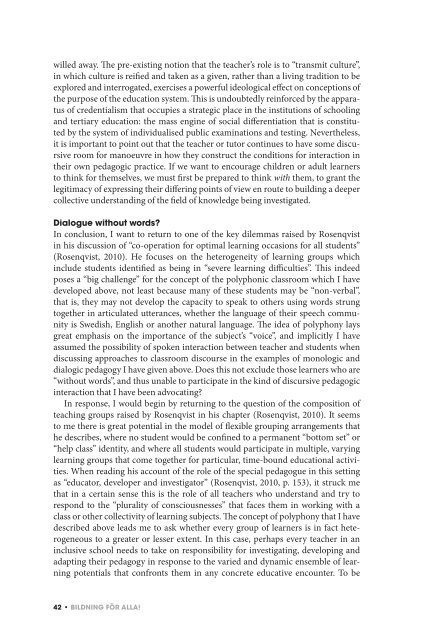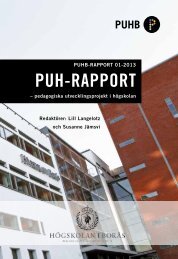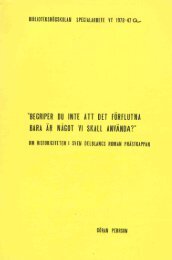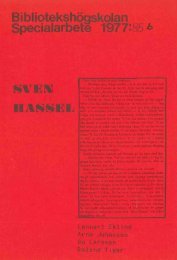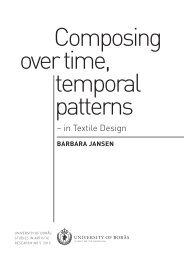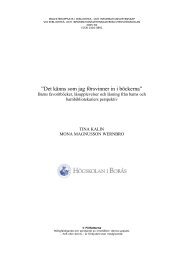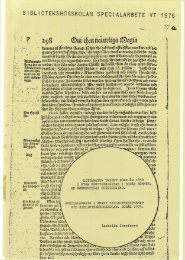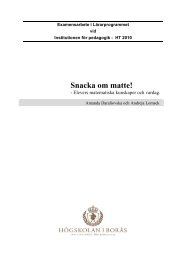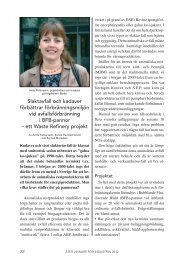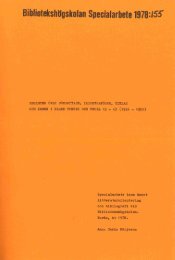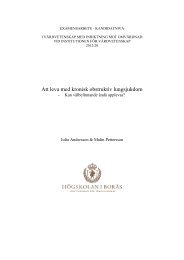Bildning för alla! - DiVA
Bildning för alla! - DiVA
Bildning för alla! - DiVA
You also want an ePaper? Increase the reach of your titles
YUMPU automatically turns print PDFs into web optimized ePapers that Google loves.
willed away. The pre-existing notion that the teacher’s role is to “transmit culture”,<br />
in which culture is reified and taken as a given, rather than a living tradition to be<br />
explored and interrogated, exercises a powerful ideological effect on conceptions of<br />
the purpose of the education system. This is undoubtedly reinforced by the apparatus<br />
of credentialism that occupies a strategic place in the institutions of schooling<br />
and tertiary education: the mass engine of social differentiation that is constituted<br />
by the system of individualised public examinations and testing. Nevertheless,<br />
it is important to point out that the teacher or tutor continues to have some discursive<br />
room for manoeuvre in how they construct the conditions for interaction in<br />
their own pedagogic practice. If we want to encourage children or adult learners<br />
to think for themselves, we must first be prepared to think with them, to grant the<br />
legitimacy of expressing their differing points of view en route to building a deeper<br />
collective understanding of the field of knowledge being investigated.<br />
Dialogue without words?<br />
In conclusion, I want to return to one of the key dilemmas raised by Rosenqvist<br />
in his discussion of “co-operation for optimal learning occasions for all students”<br />
(Rosenqvist, 2010). He focuses on the heterogeneity of learning groups which<br />
include students identified as being in “severe learning difficulties”. This indeed<br />
poses a “big challenge” for the concept of the polyphonic classroom which I have<br />
developed above, not least because many of these students may be “non-verbal”,<br />
that is, they may not develop the capacity to speak to others using words strung<br />
together in articulated utterances, whether the language of their speech community<br />
is Swedish, English or another natural language. The idea of polyphony lays<br />
great emphasis on the importance of the subject’s “voice”, and implicitly I have<br />
assumed the possibility of spoken interaction between teacher and students when<br />
discussing approaches to classroom discourse in the examples of monologic and<br />
dialogic pedagogy I have given above. Does this not exclude those learners who are<br />
“without words”, and thus unable to participate in the kind of discursive pedagogic<br />
interaction that I have been advocating?<br />
In response, I would begin by returning to the question of the composition of<br />
teaching groups raised by Rosenqvist in his chapter (Rosenqvist, 2010). It seems<br />
to me there is great potential in the model of flexible grouping arrangements that<br />
he describes, where no student would be confined to a permanent “bottom set” or<br />
“help class” identity, and where all students would participate in multiple, varying<br />
learning groups that come together for particular, time-bound educational activities.<br />
When reading his account of the role of the special pedagogue in this setting<br />
as “educator, developer and investigator” (Rosenqvist, 2010, p. 153), it struck me<br />
that in a certain sense this is the role of all teachers who understand and try to<br />
respond to the “plurality of consciousnesses” that faces them in working with a<br />
class or other collectivity of learning subjects. The concept of polyphony that I have<br />
described above leads me to ask whether every group of learners is in fact heterogeneous<br />
to a greater or lesser extent. In this case, perhaps every teacher in an<br />
inclusive school needs to take on responsibility for investigating, developing and<br />
adapting their pedagogy in response to the varied and dynamic ensemble of learning<br />
potentials that confronts them in any concrete educative encounter. To be<br />
42 • BilDning fÖr AllA!


